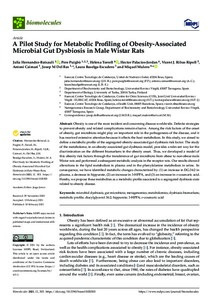A Pilot Study for Metabolic Profiling of Obesity-Associated Microbial Gut Dysbiosis in Male Wistar Rats
Baselga-Escudero Laura; Torrell Helena; Palacios-Jordan Hector; Mulero Miquel; Ripoll Vicent J. Ribas; Puigbo Pere; Hernandez-Baixauli Julia; Del Bas Josep M.; Caimari Antoni
A Pilot Study for Metabolic Profiling of Obesity-Associated Microbial Gut Dysbiosis in Male Wistar Rats
Baselga-Escudero Laura
Torrell Helena
Palacios-Jordan Hector
Mulero Miquel
Ripoll Vicent J. Ribas
Puigbo Pere
Hernandez-Baixauli Julia
Del Bas Josep M.
Caimari Antoni
MDPI
Julkaisun pysyvä osoite on:
https://urn.fi/URN:NBN:fi-fe2021093048102
https://urn.fi/URN:NBN:fi-fe2021093048102
Tiivistelmä
Obesity is one of the most incident and concerning disease worldwide. Definite strategies to prevent obesity and related complications remain elusive. Among the risk factors of the onset of obesity, gut microbiota might play an important role in the pathogenesis of the disease, and it has received extensive attention because it affects the host metabolism. In this study, we aimed to define a metabolic profile of the segregated obesity-associated gut dysbiosis risk factor. The study of the metabolome, in an obesity-associated gut dysbiosis model, provides a relevant way for the discrimination on the different biomarkers in the obesity onset. Thus, we developed a model of this obesity risk factors through the transference of gut microbiota from obese to non-obese male Wistar rats and performed a subsequent metabolic analysis in the receptor rats. Our results showed alterations in the lipid metabolism in plasma and in the phenylalanine metabolism in urine. In consequence, we have identified metabolic changes characterized by: (1) an increase in DG:34:2 in plasma, a decrease in hippurate, (2) an increase in 3-HPPA, and (3) an increase in o-coumaric acid. Hereby, we propose these metabolites as a metabolic profile associated to a segregated dysbiosis state related to obesity disease.
Kokoelmat
- Rinnakkaistallenteet [19249]
